Key Information on Varta AG IPO: Group Structure, Market & Competitors, Business Model, Risk Factors, Financial Data, Shareholders
VerifiedAdded on 2022/12/09
|11
|3483
|169
AI Summary
This case study provides key information on Varta AG's IPO, including group structure, market and competitors, business model, risk factors, financial data, and existing shareholders.
Contribute Materials
Your contribution can guide someone’s learning journey. Share your
documents today.
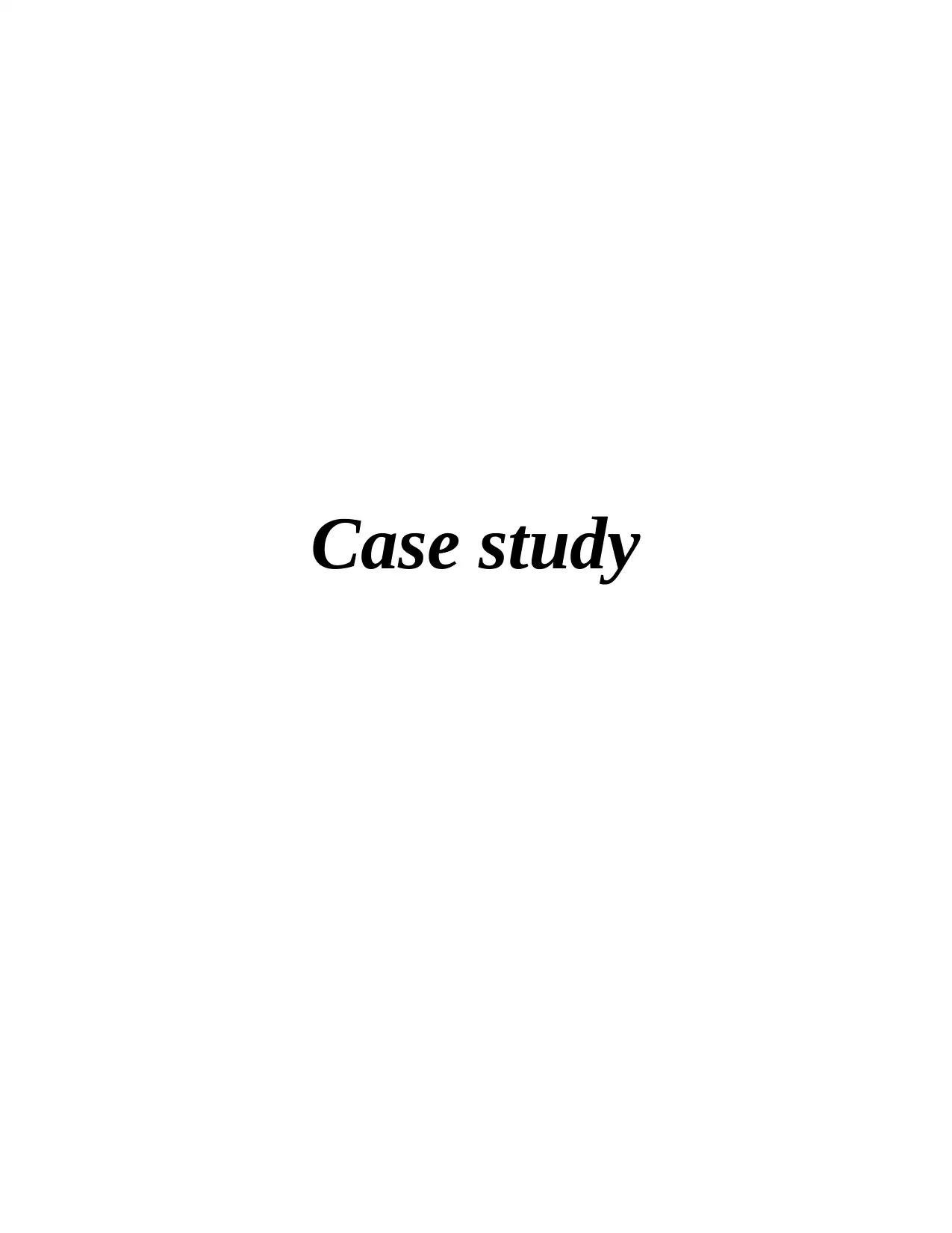
Case study
Secure Best Marks with AI Grader
Need help grading? Try our AI Grader for instant feedback on your assignments.
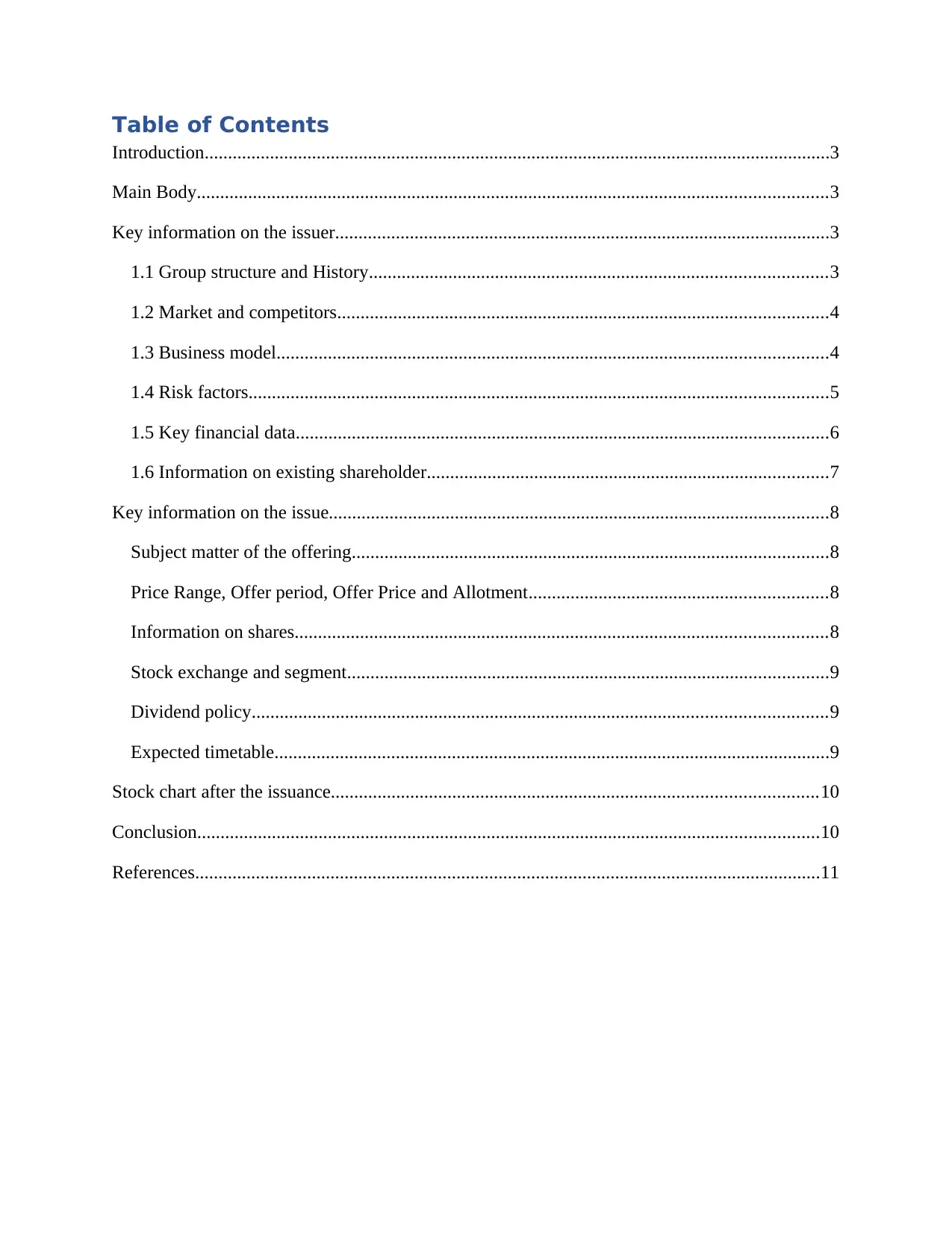
Table of Contents
Introduction......................................................................................................................................3
Main Body.......................................................................................................................................3
Key information on the issuer..........................................................................................................3
1.1 Group structure and History..................................................................................................3
1.2 Market and competitors.........................................................................................................4
1.3 Business model......................................................................................................................4
1.4 Risk factors............................................................................................................................5
1.5 Key financial data..................................................................................................................6
1.6 Information on existing shareholder......................................................................................7
Key information on the issue...........................................................................................................8
Subject matter of the offering......................................................................................................8
Price Range, Offer period, Offer Price and Allotment................................................................8
Information on shares..................................................................................................................8
Stock exchange and segment.......................................................................................................9
Dividend policy...........................................................................................................................9
Expected timetable.......................................................................................................................9
Stock chart after the issuance........................................................................................................10
Conclusion.....................................................................................................................................10
References......................................................................................................................................11
Introduction......................................................................................................................................3
Main Body.......................................................................................................................................3
Key information on the issuer..........................................................................................................3
1.1 Group structure and History..................................................................................................3
1.2 Market and competitors.........................................................................................................4
1.3 Business model......................................................................................................................4
1.4 Risk factors............................................................................................................................5
1.5 Key financial data..................................................................................................................6
1.6 Information on existing shareholder......................................................................................7
Key information on the issue...........................................................................................................8
Subject matter of the offering......................................................................................................8
Price Range, Offer period, Offer Price and Allotment................................................................8
Information on shares..................................................................................................................8
Stock exchange and segment.......................................................................................................9
Dividend policy...........................................................................................................................9
Expected timetable.......................................................................................................................9
Stock chart after the issuance........................................................................................................10
Conclusion.....................................................................................................................................10
References......................................................................................................................................11
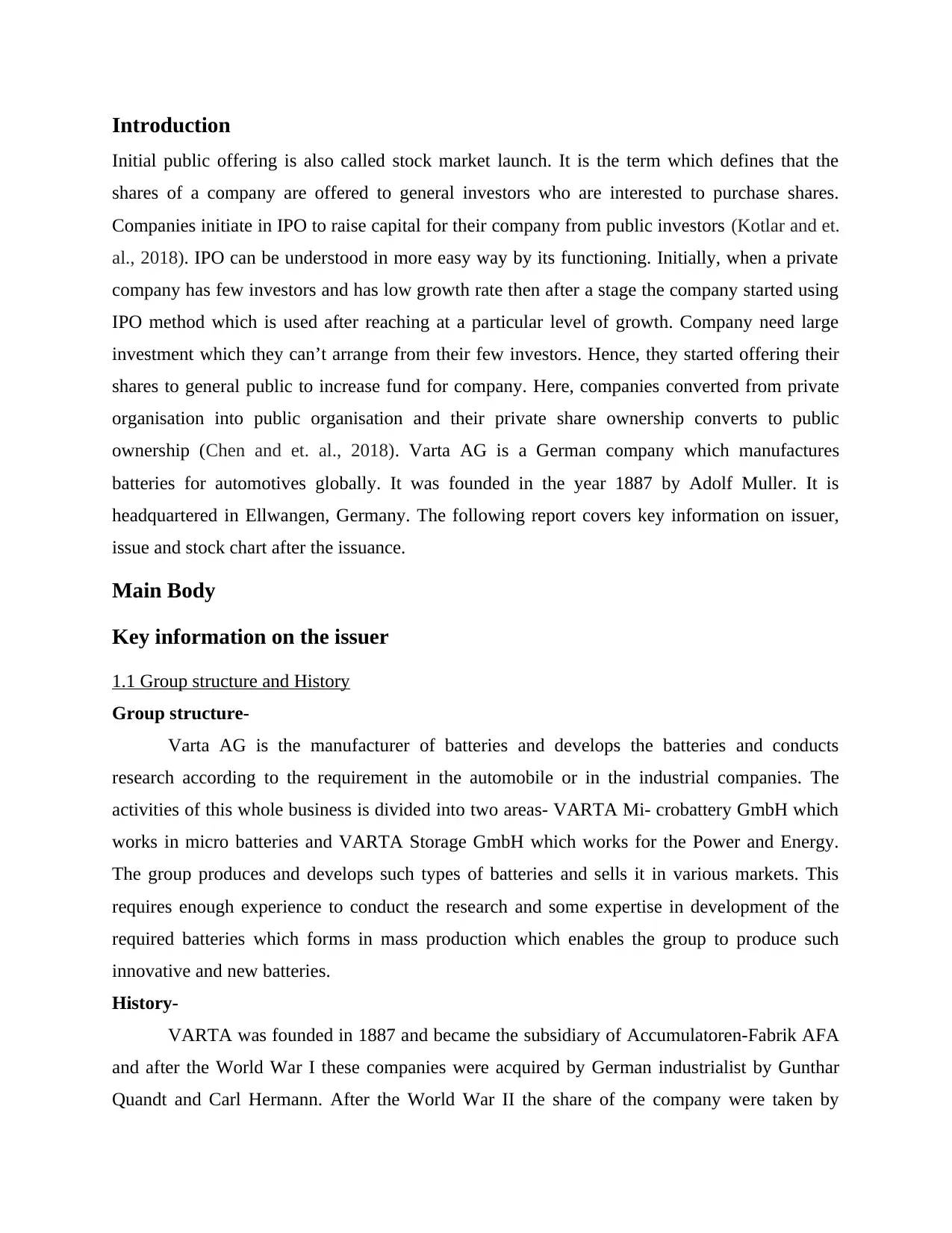
Introduction
Initial public offering is also called stock market launch. It is the term which defines that the
shares of a company are offered to general investors who are interested to purchase shares.
Companies initiate in IPO to raise capital for their company from public investors (Kotlar and et.
al., 2018). IPO can be understood in more easy way by its functioning. Initially, when a private
company has few investors and has low growth rate then after a stage the company started using
IPO method which is used after reaching at a particular level of growth. Company need large
investment which they can’t arrange from their few investors. Hence, they started offering their
shares to general public to increase fund for company. Here, companies converted from private
organisation into public organisation and their private share ownership converts to public
ownership (Chen and et. al., 2018). Varta AG is a German company which manufactures
batteries for automotives globally. It was founded in the year 1887 by Adolf Muller. It is
headquartered in Ellwangen, Germany. The following report covers key information on issuer,
issue and stock chart after the issuance.
Main Body
Key information on the issuer
1.1 Group structure and History
Group structure-
Varta AG is the manufacturer of batteries and develops the batteries and conducts
research according to the requirement in the automobile or in the industrial companies. The
activities of this whole business is divided into two areas- VARTA Mi- crobattery GmbH which
works in micro batteries and VARTA Storage GmbH which works for the Power and Energy.
The group produces and develops such types of batteries and sells it in various markets. This
requires enough experience to conduct the research and some expertise in development of the
required batteries which forms in mass production which enables the group to produce such
innovative and new batteries.
History-
VARTA was founded in 1887 and became the subsidiary of Accumulatoren-Fabrik AFA
and after the World War I these companies were acquired by German industrialist by Gunthar
Quandt and Carl Hermann. After the World War II the share of the company were taken by
Initial public offering is also called stock market launch. It is the term which defines that the
shares of a company are offered to general investors who are interested to purchase shares.
Companies initiate in IPO to raise capital for their company from public investors (Kotlar and et.
al., 2018). IPO can be understood in more easy way by its functioning. Initially, when a private
company has few investors and has low growth rate then after a stage the company started using
IPO method which is used after reaching at a particular level of growth. Company need large
investment which they can’t arrange from their few investors. Hence, they started offering their
shares to general public to increase fund for company. Here, companies converted from private
organisation into public organisation and their private share ownership converts to public
ownership (Chen and et. al., 2018). Varta AG is a German company which manufactures
batteries for automotives globally. It was founded in the year 1887 by Adolf Muller. It is
headquartered in Ellwangen, Germany. The following report covers key information on issuer,
issue and stock chart after the issuance.
Main Body
Key information on the issuer
1.1 Group structure and History
Group structure-
Varta AG is the manufacturer of batteries and develops the batteries and conducts
research according to the requirement in the automobile or in the industrial companies. The
activities of this whole business is divided into two areas- VARTA Mi- crobattery GmbH which
works in micro batteries and VARTA Storage GmbH which works for the Power and Energy.
The group produces and develops such types of batteries and sells it in various markets. This
requires enough experience to conduct the research and some expertise in development of the
required batteries which forms in mass production which enables the group to produce such
innovative and new batteries.
History-
VARTA was founded in 1887 and became the subsidiary of Accumulatoren-Fabrik AFA
and after the World War I these companies were acquired by German industrialist by Gunthar
Quandt and Carl Hermann. After the World War II the share of the company were taken by
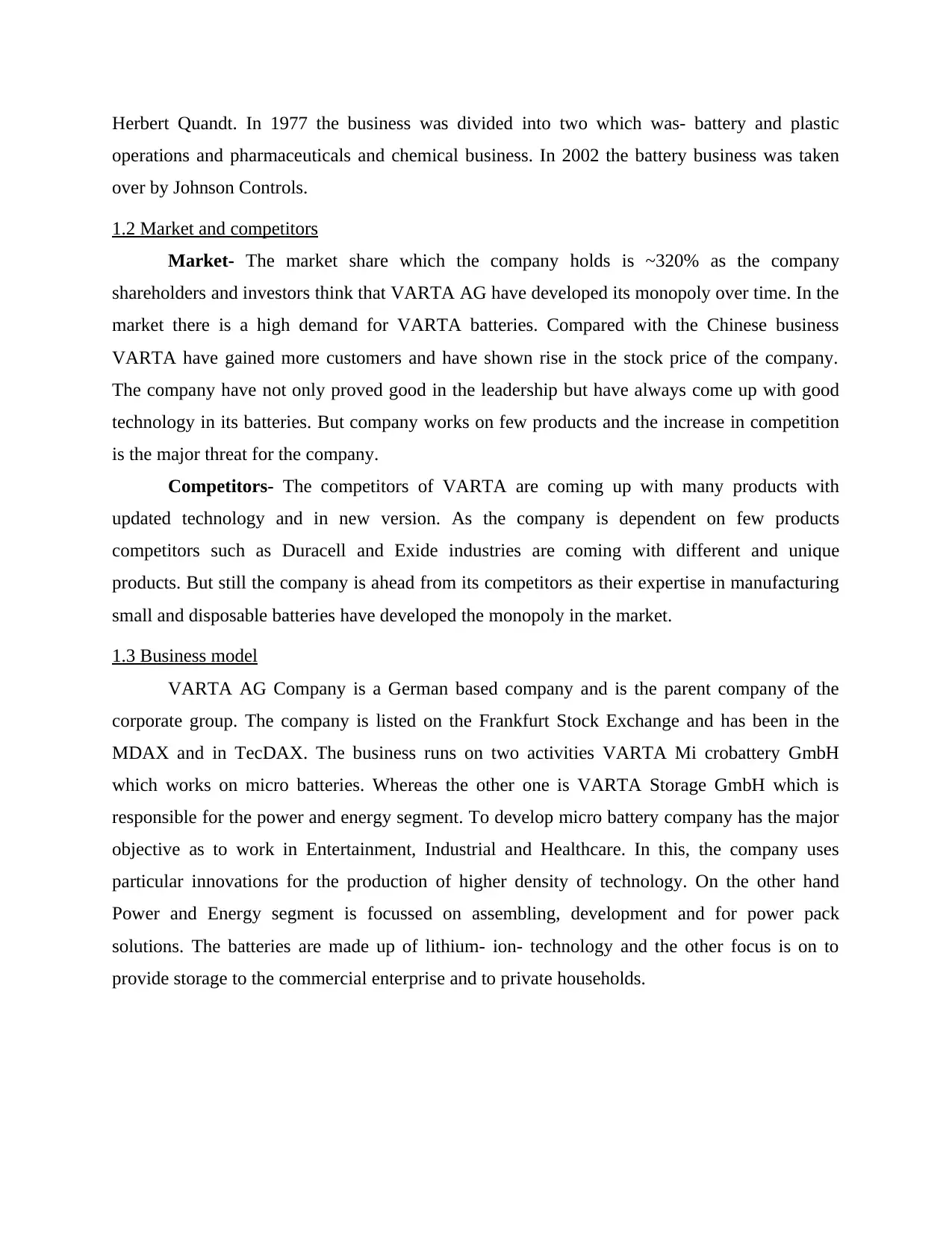
Herbert Quandt. In 1977 the business was divided into two which was- battery and plastic
operations and pharmaceuticals and chemical business. In 2002 the battery business was taken
over by Johnson Controls.
1.2 Market and competitors
Market- The market share which the company holds is ~320% as the company
shareholders and investors think that VARTA AG have developed its monopoly over time. In the
market there is a high demand for VARTA batteries. Compared with the Chinese business
VARTA have gained more customers and have shown rise in the stock price of the company.
The company have not only proved good in the leadership but have always come up with good
technology in its batteries. But company works on few products and the increase in competition
is the major threat for the company.
Competitors- The competitors of VARTA are coming up with many products with
updated technology and in new version. As the company is dependent on few products
competitors such as Duracell and Exide industries are coming with different and unique
products. But still the company is ahead from its competitors as their expertise in manufacturing
small and disposable batteries have developed the monopoly in the market.
1.3 Business model
VARTA AG Company is a German based company and is the parent company of the
corporate group. The company is listed on the Frankfurt Stock Exchange and has been in the
MDAX and in TecDAX. The business runs on two activities VARTA Mi crobattery GmbH
which works on micro batteries. Whereas the other one is VARTA Storage GmbH which is
responsible for the power and energy segment. To develop micro battery company has the major
objective as to work in Entertainment, Industrial and Healthcare. In this, the company uses
particular innovations for the production of higher density of technology. On the other hand
Power and Energy segment is focussed on assembling, development and for power pack
solutions. The batteries are made up of lithium- ion- technology and the other focus is on to
provide storage to the commercial enterprise and to private households.
operations and pharmaceuticals and chemical business. In 2002 the battery business was taken
over by Johnson Controls.
1.2 Market and competitors
Market- The market share which the company holds is ~320% as the company
shareholders and investors think that VARTA AG have developed its monopoly over time. In the
market there is a high demand for VARTA batteries. Compared with the Chinese business
VARTA have gained more customers and have shown rise in the stock price of the company.
The company have not only proved good in the leadership but have always come up with good
technology in its batteries. But company works on few products and the increase in competition
is the major threat for the company.
Competitors- The competitors of VARTA are coming up with many products with
updated technology and in new version. As the company is dependent on few products
competitors such as Duracell and Exide industries are coming with different and unique
products. But still the company is ahead from its competitors as their expertise in manufacturing
small and disposable batteries have developed the monopoly in the market.
1.3 Business model
VARTA AG Company is a German based company and is the parent company of the
corporate group. The company is listed on the Frankfurt Stock Exchange and has been in the
MDAX and in TecDAX. The business runs on two activities VARTA Mi crobattery GmbH
which works on micro batteries. Whereas the other one is VARTA Storage GmbH which is
responsible for the power and energy segment. To develop micro battery company has the major
objective as to work in Entertainment, Industrial and Healthcare. In this, the company uses
particular innovations for the production of higher density of technology. On the other hand
Power and Energy segment is focussed on assembling, development and for power pack
solutions. The batteries are made up of lithium- ion- technology and the other focus is on to
provide storage to the commercial enterprise and to private households.
Secure Best Marks with AI Grader
Need help grading? Try our AI Grader for instant feedback on your assignments.
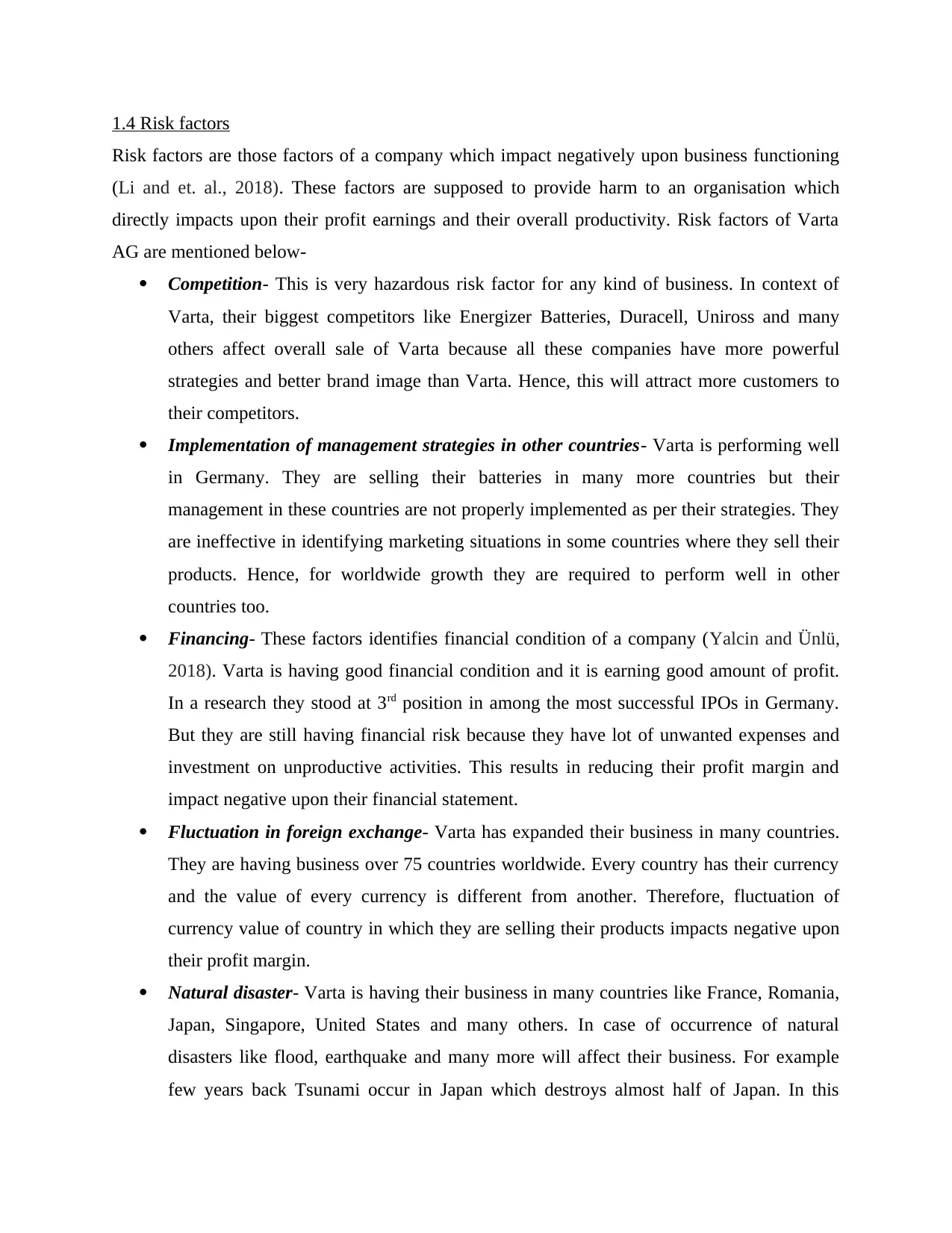
1.4 Risk factors
Risk factors are those factors of a company which impact negatively upon business functioning
(Li and et. al., 2018). These factors are supposed to provide harm to an organisation which
directly impacts upon their profit earnings and their overall productivity. Risk factors of Varta
AG are mentioned below-
Competition- This is very hazardous risk factor for any kind of business. In context of
Varta, their biggest competitors like Energizer Batteries, Duracell, Uniross and many
others affect overall sale of Varta because all these companies have more powerful
strategies and better brand image than Varta. Hence, this will attract more customers to
their competitors.
Implementation of management strategies in other countries- Varta is performing well
in Germany. They are selling their batteries in many more countries but their
management in these countries are not properly implemented as per their strategies. They
are ineffective in identifying marketing situations in some countries where they sell their
products. Hence, for worldwide growth they are required to perform well in other
countries too.
Financing- These factors identifies financial condition of a company (Yalcin and Ünlü,
2018). Varta is having good financial condition and it is earning good amount of profit.
In a research they stood at 3rd position in among the most successful IPOs in Germany.
But they are still having financial risk because they have lot of unwanted expenses and
investment on unproductive activities. This results in reducing their profit margin and
impact negative upon their financial statement.
Fluctuation in foreign exchange- Varta has expanded their business in many countries.
They are having business over 75 countries worldwide. Every country has their currency
and the value of every currency is different from another. Therefore, fluctuation of
currency value of country in which they are selling their products impacts negative upon
their profit margin.
Natural disaster- Varta is having their business in many countries like France, Romania,
Japan, Singapore, United States and many others. In case of occurrence of natural
disasters like flood, earthquake and many more will affect their business. For example
few years back Tsunami occur in Japan which destroys almost half of Japan. In this
Risk factors are those factors of a company which impact negatively upon business functioning
(Li and et. al., 2018). These factors are supposed to provide harm to an organisation which
directly impacts upon their profit earnings and their overall productivity. Risk factors of Varta
AG are mentioned below-
Competition- This is very hazardous risk factor for any kind of business. In context of
Varta, their biggest competitors like Energizer Batteries, Duracell, Uniross and many
others affect overall sale of Varta because all these companies have more powerful
strategies and better brand image than Varta. Hence, this will attract more customers to
their competitors.
Implementation of management strategies in other countries- Varta is performing well
in Germany. They are selling their batteries in many more countries but their
management in these countries are not properly implemented as per their strategies. They
are ineffective in identifying marketing situations in some countries where they sell their
products. Hence, for worldwide growth they are required to perform well in other
countries too.
Financing- These factors identifies financial condition of a company (Yalcin and Ünlü,
2018). Varta is having good financial condition and it is earning good amount of profit.
In a research they stood at 3rd position in among the most successful IPOs in Germany.
But they are still having financial risk because they have lot of unwanted expenses and
investment on unproductive activities. This results in reducing their profit margin and
impact negative upon their financial statement.
Fluctuation in foreign exchange- Varta has expanded their business in many countries.
They are having business over 75 countries worldwide. Every country has their currency
and the value of every currency is different from another. Therefore, fluctuation of
currency value of country in which they are selling their products impacts negative upon
their profit margin.
Natural disaster- Varta is having their business in many countries like France, Romania,
Japan, Singapore, United States and many others. In case of occurrence of natural
disasters like flood, earthquake and many more will affect their business. For example
few years back Tsunami occur in Japan which destroys almost half of Japan. In this
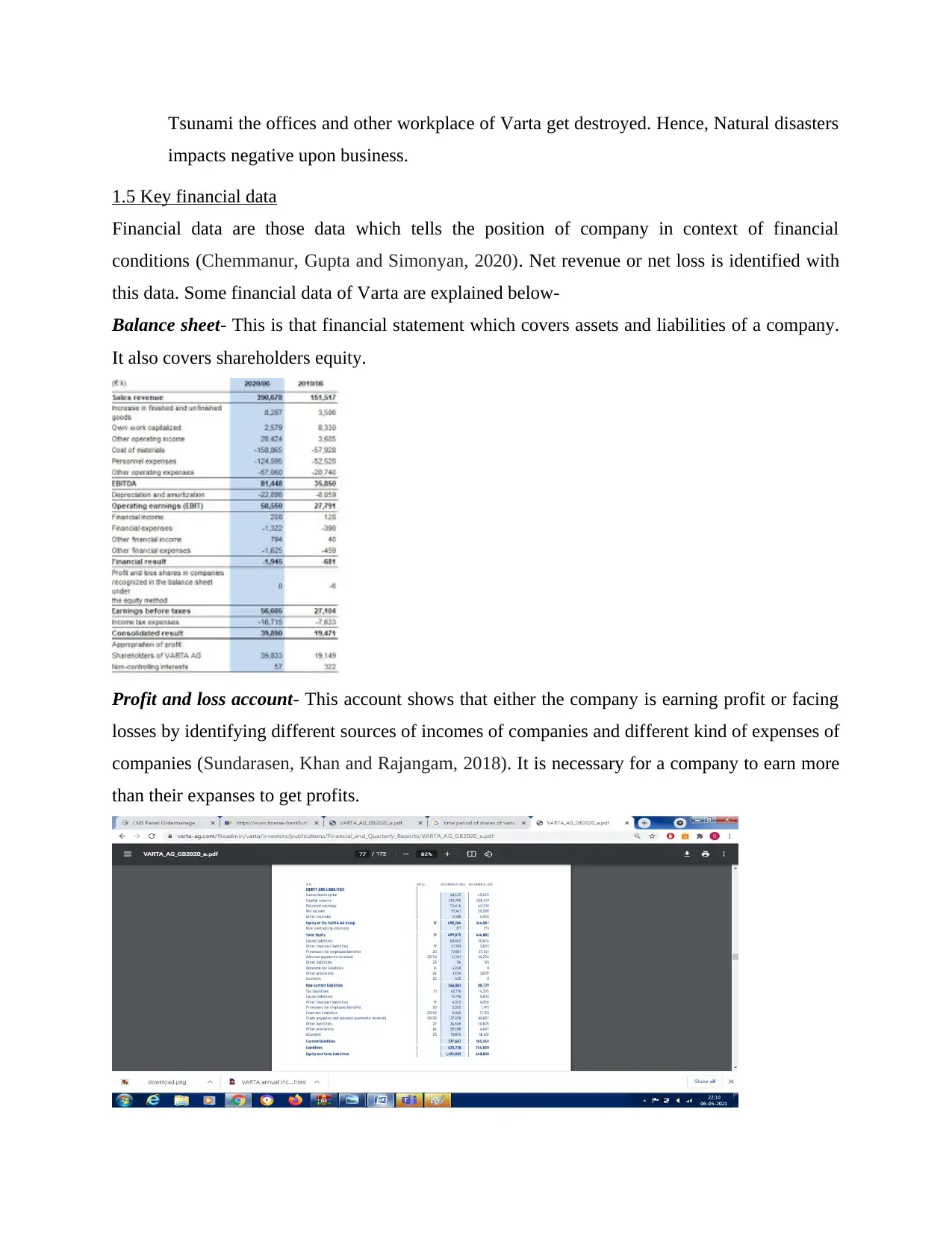
Tsunami the offices and other workplace of Varta get destroyed. Hence, Natural disasters
impacts negative upon business.
1.5 Key financial data
Financial data are those data which tells the position of company in context of financial
conditions (Chemmanur, Gupta and Simonyan, 2020). Net revenue or net loss is identified with
this data. Some financial data of Varta are explained below-
Balance sheet- This is that financial statement which covers assets and liabilities of a company.
It also covers shareholders equity.
Profit and loss account- This account shows that either the company is earning profit or facing
losses by identifying different sources of incomes of companies and different kind of expenses of
companies (Sundarasen, Khan and Rajangam, 2018). It is necessary for a company to earn more
than their expanses to get profits.
impacts negative upon business.
1.5 Key financial data
Financial data are those data which tells the position of company in context of financial
conditions (Chemmanur, Gupta and Simonyan, 2020). Net revenue or net loss is identified with
this data. Some financial data of Varta are explained below-
Balance sheet- This is that financial statement which covers assets and liabilities of a company.
It also covers shareholders equity.
Profit and loss account- This account shows that either the company is earning profit or facing
losses by identifying different sources of incomes of companies and different kind of expenses of
companies (Sundarasen, Khan and Rajangam, 2018). It is necessary for a company to earn more
than their expanses to get profits.
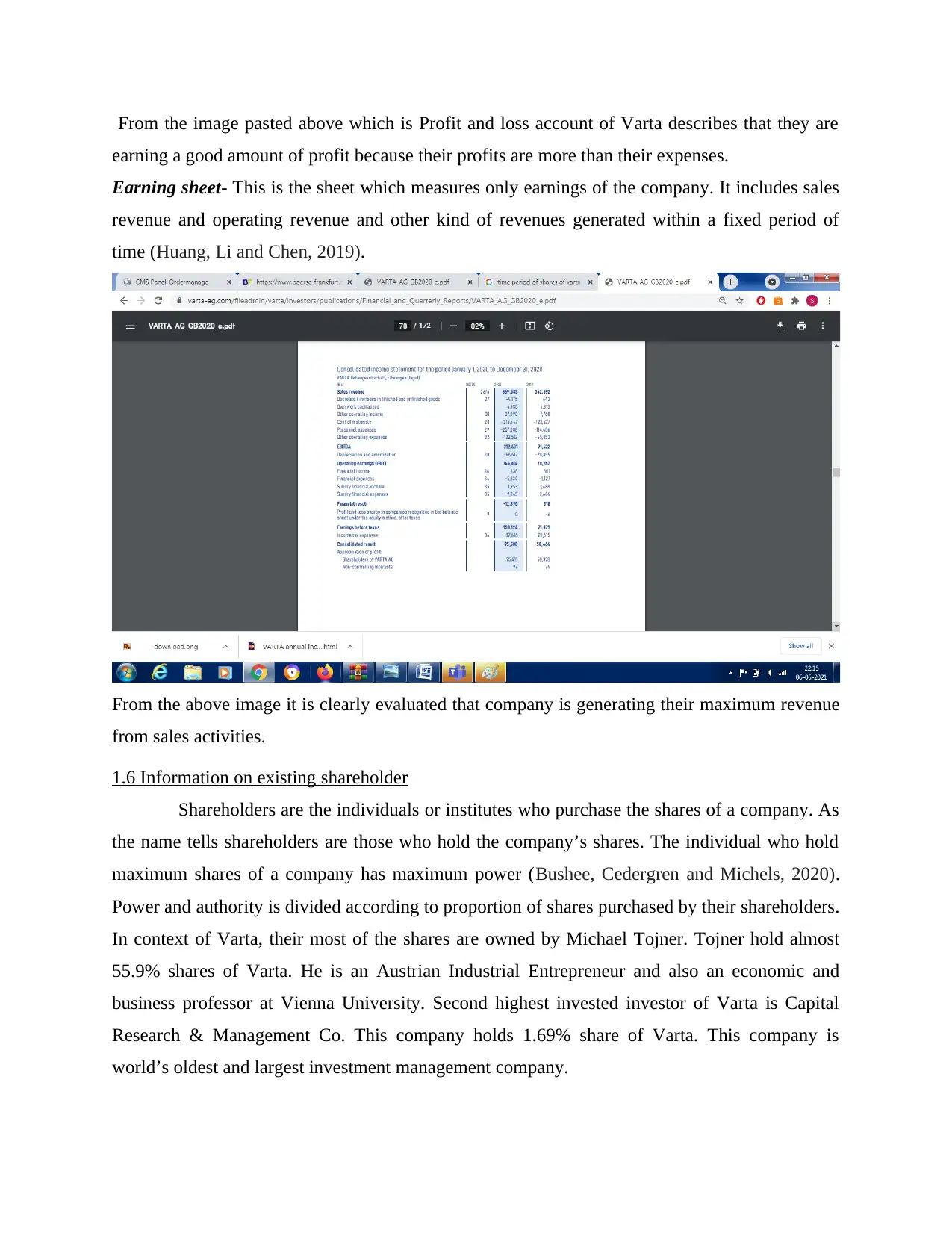
From the image pasted above which is Profit and loss account of Varta describes that they are
earning a good amount of profit because their profits are more than their expenses.
Earning sheet- This is the sheet which measures only earnings of the company. It includes sales
revenue and operating revenue and other kind of revenues generated within a fixed period of
time (Huang, Li and Chen, 2019).
From the above image it is clearly evaluated that company is generating their maximum revenue
from sales activities.
1.6 Information on existing shareholder
Shareholders are the individuals or institutes who purchase the shares of a company. As
the name tells shareholders are those who hold the company’s shares. The individual who hold
maximum shares of a company has maximum power (Bushee, Cedergren and Michels, 2020).
Power and authority is divided according to proportion of shares purchased by their shareholders.
In context of Varta, their most of the shares are owned by Michael Tojner. Tojner hold almost
55.9% shares of Varta. He is an Austrian Industrial Entrepreneur and also an economic and
business professor at Vienna University. Second highest invested investor of Varta is Capital
Research & Management Co. This company holds 1.69% share of Varta. This company is
world’s oldest and largest investment management company.
earning a good amount of profit because their profits are more than their expenses.
Earning sheet- This is the sheet which measures only earnings of the company. It includes sales
revenue and operating revenue and other kind of revenues generated within a fixed period of
time (Huang, Li and Chen, 2019).
From the above image it is clearly evaluated that company is generating their maximum revenue
from sales activities.
1.6 Information on existing shareholder
Shareholders are the individuals or institutes who purchase the shares of a company. As
the name tells shareholders are those who hold the company’s shares. The individual who hold
maximum shares of a company has maximum power (Bushee, Cedergren and Michels, 2020).
Power and authority is divided according to proportion of shares purchased by their shareholders.
In context of Varta, their most of the shares are owned by Michael Tojner. Tojner hold almost
55.9% shares of Varta. He is an Austrian Industrial Entrepreneur and also an economic and
business professor at Vienna University. Second highest invested investor of Varta is Capital
Research & Management Co. This company holds 1.69% share of Varta. This company is
world’s oldest and largest investment management company.
Paraphrase This Document
Need a fresh take? Get an instant paraphrase of this document with our AI Paraphraser
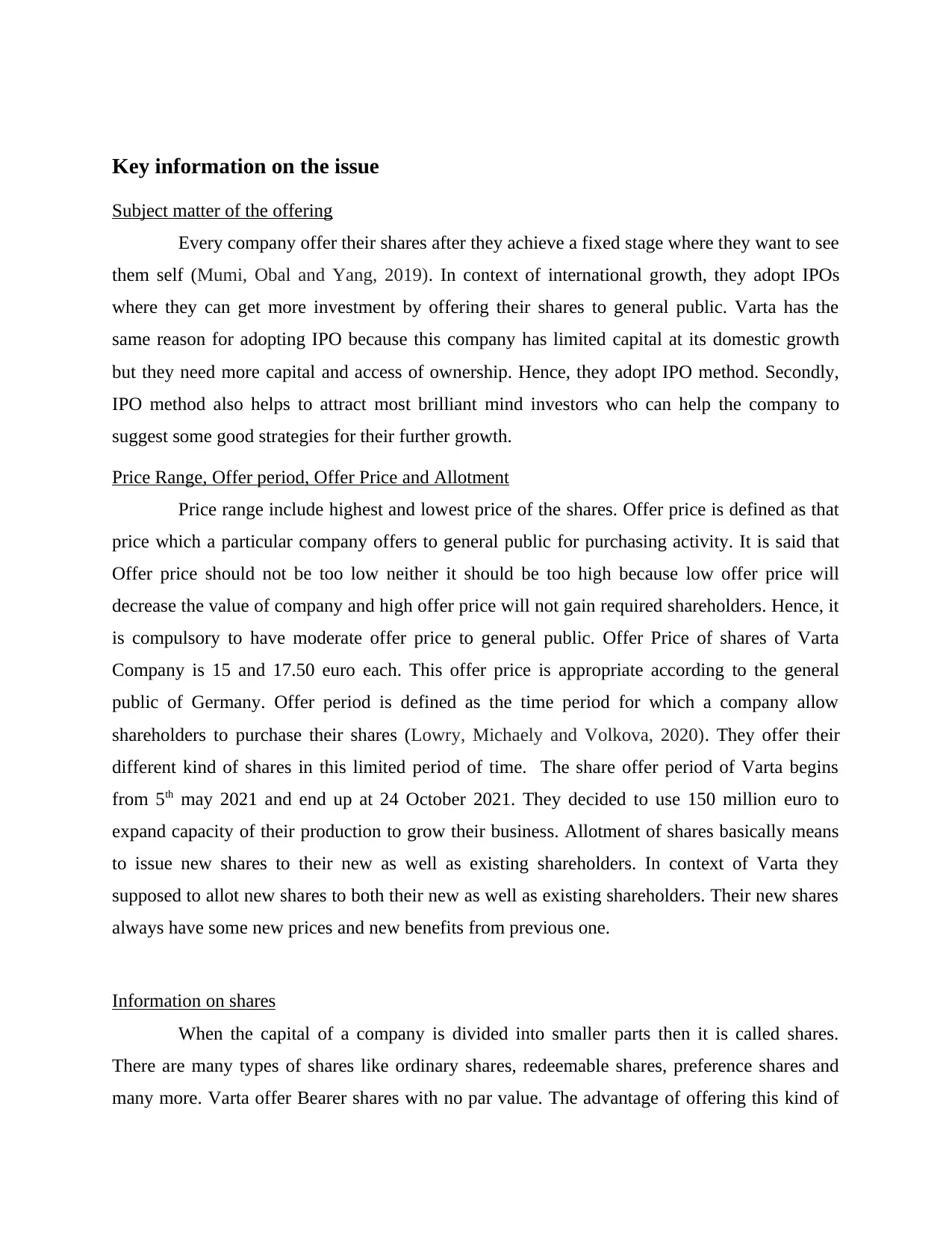
Key information on the issue
Subject matter of the offering
Every company offer their shares after they achieve a fixed stage where they want to see
them self (Mumi, Obal and Yang, 2019). In context of international growth, they adopt IPOs
where they can get more investment by offering their shares to general public. Varta has the
same reason for adopting IPO because this company has limited capital at its domestic growth
but they need more capital and access of ownership. Hence, they adopt IPO method. Secondly,
IPO method also helps to attract most brilliant mind investors who can help the company to
suggest some good strategies for their further growth.
Price Range, Offer period, Offer Price and Allotment
Price range include highest and lowest price of the shares. Offer price is defined as that
price which a particular company offers to general public for purchasing activity. It is said that
Offer price should not be too low neither it should be too high because low offer price will
decrease the value of company and high offer price will not gain required shareholders. Hence, it
is compulsory to have moderate offer price to general public. Offer Price of shares of Varta
Company is 15 and 17.50 euro each. This offer price is appropriate according to the general
public of Germany. Offer period is defined as the time period for which a company allow
shareholders to purchase their shares (Lowry, Michaely and Volkova, 2020). They offer their
different kind of shares in this limited period of time. The share offer period of Varta begins
from 5th may 2021 and end up at 24 October 2021. They decided to use 150 million euro to
expand capacity of their production to grow their business. Allotment of shares basically means
to issue new shares to their new as well as existing shareholders. In context of Varta they
supposed to allot new shares to both their new as well as existing shareholders. Their new shares
always have some new prices and new benefits from previous one.
Information on shares
When the capital of a company is divided into smaller parts then it is called shares.
There are many types of shares like ordinary shares, redeemable shares, preference shares and
many more. Varta offer Bearer shares with no par value. The advantage of offering this kind of
Subject matter of the offering
Every company offer their shares after they achieve a fixed stage where they want to see
them self (Mumi, Obal and Yang, 2019). In context of international growth, they adopt IPOs
where they can get more investment by offering their shares to general public. Varta has the
same reason for adopting IPO because this company has limited capital at its domestic growth
but they need more capital and access of ownership. Hence, they adopt IPO method. Secondly,
IPO method also helps to attract most brilliant mind investors who can help the company to
suggest some good strategies for their further growth.
Price Range, Offer period, Offer Price and Allotment
Price range include highest and lowest price of the shares. Offer price is defined as that
price which a particular company offers to general public for purchasing activity. It is said that
Offer price should not be too low neither it should be too high because low offer price will
decrease the value of company and high offer price will not gain required shareholders. Hence, it
is compulsory to have moderate offer price to general public. Offer Price of shares of Varta
Company is 15 and 17.50 euro each. This offer price is appropriate according to the general
public of Germany. Offer period is defined as the time period for which a company allow
shareholders to purchase their shares (Lowry, Michaely and Volkova, 2020). They offer their
different kind of shares in this limited period of time. The share offer period of Varta begins
from 5th may 2021 and end up at 24 October 2021. They decided to use 150 million euro to
expand capacity of their production to grow their business. Allotment of shares basically means
to issue new shares to their new as well as existing shareholders. In context of Varta they
supposed to allot new shares to both their new as well as existing shareholders. Their new shares
always have some new prices and new benefits from previous one.
Information on shares
When the capital of a company is divided into smaller parts then it is called shares.
There are many types of shares like ordinary shares, redeemable shares, preference shares and
many more. Varta offer Bearer shares with no par value. The advantage of offering this kind of
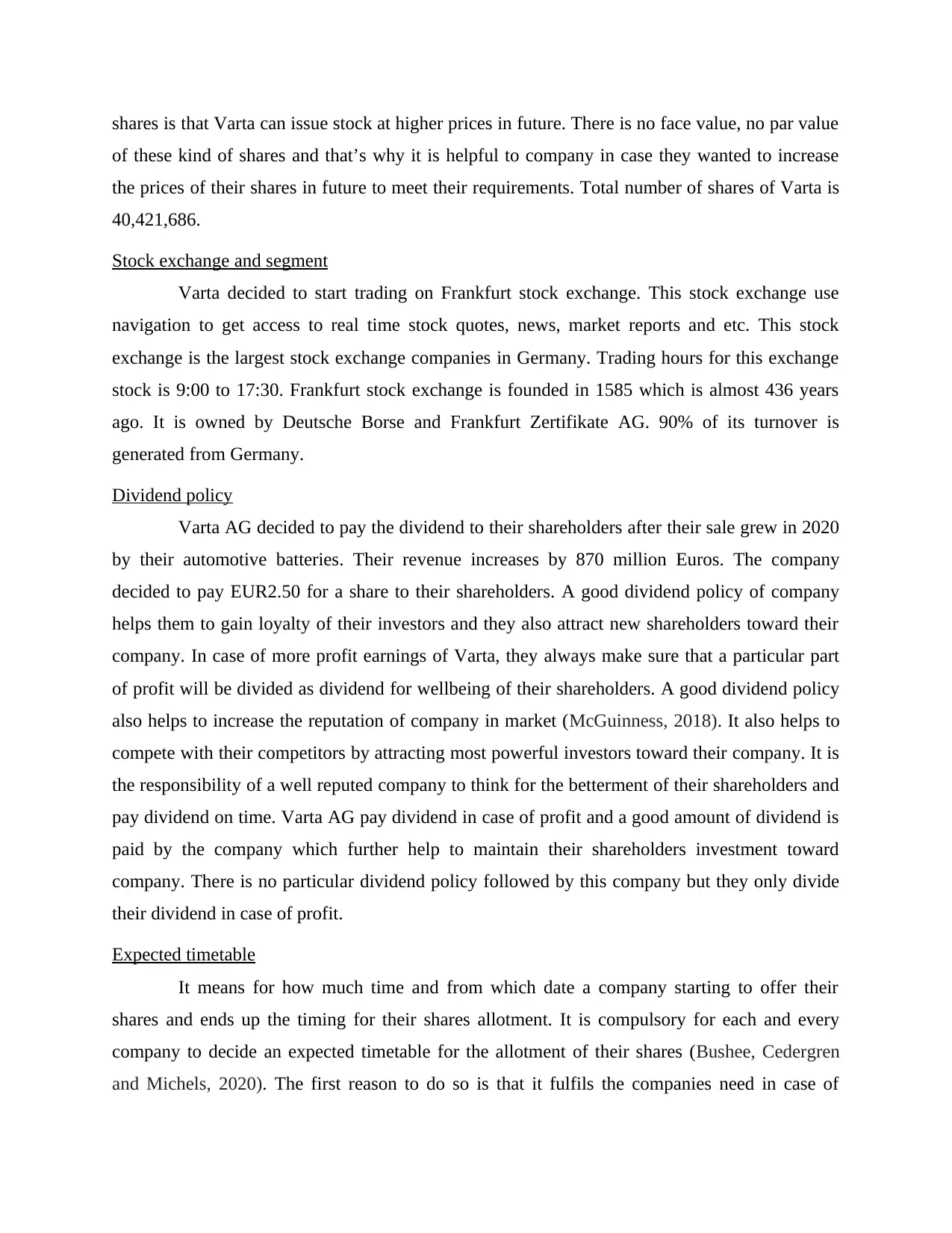
shares is that Varta can issue stock at higher prices in future. There is no face value, no par value
of these kind of shares and that’s why it is helpful to company in case they wanted to increase
the prices of their shares in future to meet their requirements. Total number of shares of Varta is
40,421,686.
Stock exchange and segment
Varta decided to start trading on Frankfurt stock exchange. This stock exchange use
navigation to get access to real time stock quotes, news, market reports and etc. This stock
exchange is the largest stock exchange companies in Germany. Trading hours for this exchange
stock is 9:00 to 17:30. Frankfurt stock exchange is founded in 1585 which is almost 436 years
ago. It is owned by Deutsche Borse and Frankfurt Zertifikate AG. 90% of its turnover is
generated from Germany.
Dividend policy
Varta AG decided to pay the dividend to their shareholders after their sale grew in 2020
by their automotive batteries. Their revenue increases by 870 million Euros. The company
decided to pay EUR2.50 for a share to their shareholders. A good dividend policy of company
helps them to gain loyalty of their investors and they also attract new shareholders toward their
company. In case of more profit earnings of Varta, they always make sure that a particular part
of profit will be divided as dividend for wellbeing of their shareholders. A good dividend policy
also helps to increase the reputation of company in market (McGuinness, 2018). It also helps to
compete with their competitors by attracting most powerful investors toward their company. It is
the responsibility of a well reputed company to think for the betterment of their shareholders and
pay dividend on time. Varta AG pay dividend in case of profit and a good amount of dividend is
paid by the company which further help to maintain their shareholders investment toward
company. There is no particular dividend policy followed by this company but they only divide
their dividend in case of profit.
Expected timetable
It means for how much time and from which date a company starting to offer their
shares and ends up the timing for their shares allotment. It is compulsory for each and every
company to decide an expected timetable for the allotment of their shares (Bushee, Cedergren
and Michels, 2020). The first reason to do so is that it fulfils the companies need in case of
of these kind of shares and that’s why it is helpful to company in case they wanted to increase
the prices of their shares in future to meet their requirements. Total number of shares of Varta is
40,421,686.
Stock exchange and segment
Varta decided to start trading on Frankfurt stock exchange. This stock exchange use
navigation to get access to real time stock quotes, news, market reports and etc. This stock
exchange is the largest stock exchange companies in Germany. Trading hours for this exchange
stock is 9:00 to 17:30. Frankfurt stock exchange is founded in 1585 which is almost 436 years
ago. It is owned by Deutsche Borse and Frankfurt Zertifikate AG. 90% of its turnover is
generated from Germany.
Dividend policy
Varta AG decided to pay the dividend to their shareholders after their sale grew in 2020
by their automotive batteries. Their revenue increases by 870 million Euros. The company
decided to pay EUR2.50 for a share to their shareholders. A good dividend policy of company
helps them to gain loyalty of their investors and they also attract new shareholders toward their
company. In case of more profit earnings of Varta, they always make sure that a particular part
of profit will be divided as dividend for wellbeing of their shareholders. A good dividend policy
also helps to increase the reputation of company in market (McGuinness, 2018). It also helps to
compete with their competitors by attracting most powerful investors toward their company. It is
the responsibility of a well reputed company to think for the betterment of their shareholders and
pay dividend on time. Varta AG pay dividend in case of profit and a good amount of dividend is
paid by the company which further help to maintain their shareholders investment toward
company. There is no particular dividend policy followed by this company but they only divide
their dividend in case of profit.
Expected timetable
It means for how much time and from which date a company starting to offer their
shares and ends up the timing for their shares allotment. It is compulsory for each and every
company to decide an expected timetable for the allotment of their shares (Bushee, Cedergren
and Michels, 2020). The first reason to do so is that it fulfils the companies need in case of
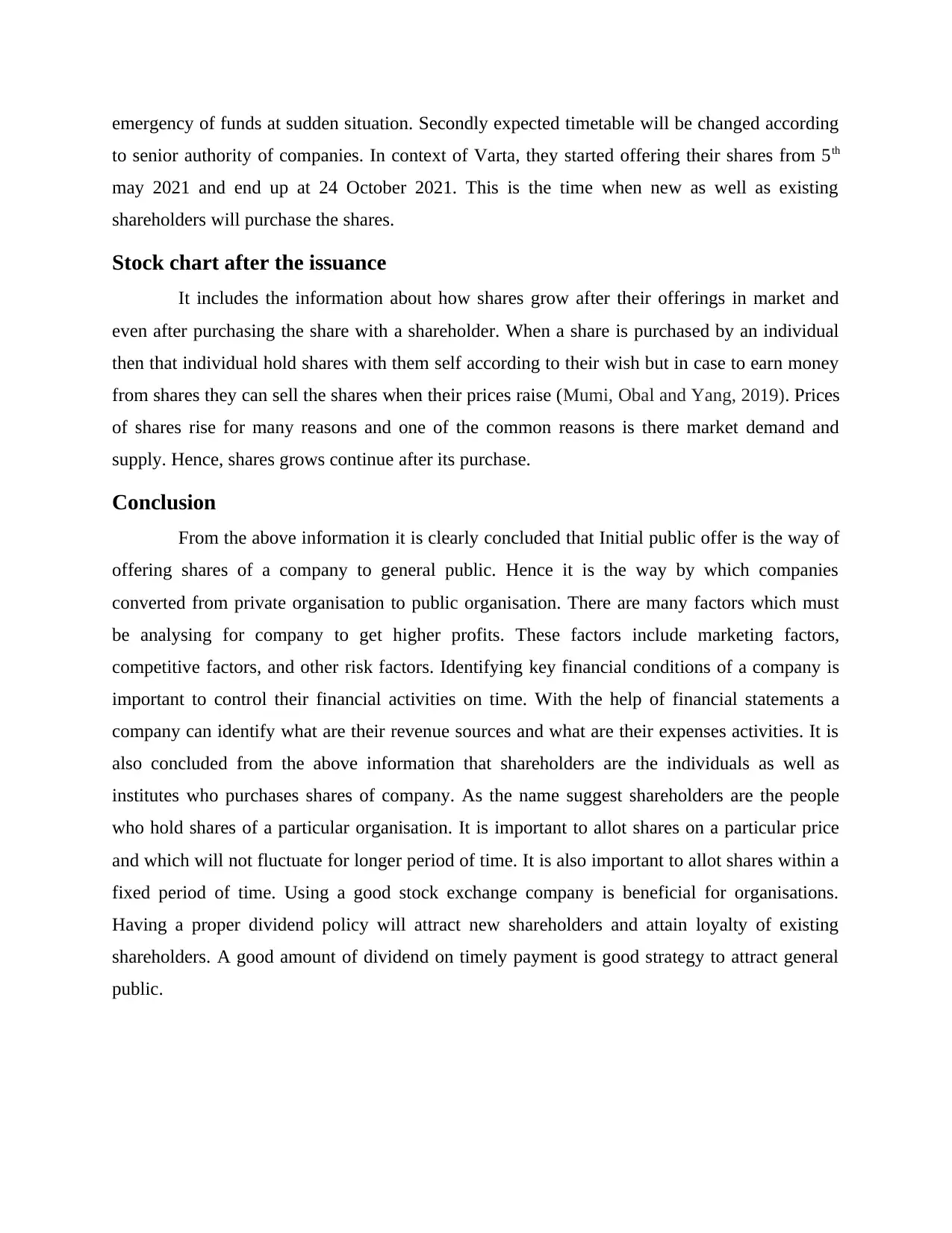
emergency of funds at sudden situation. Secondly expected timetable will be changed according
to senior authority of companies. In context of Varta, they started offering their shares from 5th
may 2021 and end up at 24 October 2021. This is the time when new as well as existing
shareholders will purchase the shares.
Stock chart after the issuance
It includes the information about how shares grow after their offerings in market and
even after purchasing the share with a shareholder. When a share is purchased by an individual
then that individual hold shares with them self according to their wish but in case to earn money
from shares they can sell the shares when their prices raise (Mumi, Obal and Yang, 2019). Prices
of shares rise for many reasons and one of the common reasons is there market demand and
supply. Hence, shares grows continue after its purchase.
Conclusion
From the above information it is clearly concluded that Initial public offer is the way of
offering shares of a company to general public. Hence it is the way by which companies
converted from private organisation to public organisation. There are many factors which must
be analysing for company to get higher profits. These factors include marketing factors,
competitive factors, and other risk factors. Identifying key financial conditions of a company is
important to control their financial activities on time. With the help of financial statements a
company can identify what are their revenue sources and what are their expenses activities. It is
also concluded from the above information that shareholders are the individuals as well as
institutes who purchases shares of company. As the name suggest shareholders are the people
who hold shares of a particular organisation. It is important to allot shares on a particular price
and which will not fluctuate for longer period of time. It is also important to allot shares within a
fixed period of time. Using a good stock exchange company is beneficial for organisations.
Having a proper dividend policy will attract new shareholders and attain loyalty of existing
shareholders. A good amount of dividend on timely payment is good strategy to attract general
public.
to senior authority of companies. In context of Varta, they started offering their shares from 5th
may 2021 and end up at 24 October 2021. This is the time when new as well as existing
shareholders will purchase the shares.
Stock chart after the issuance
It includes the information about how shares grow after their offerings in market and
even after purchasing the share with a shareholder. When a share is purchased by an individual
then that individual hold shares with them self according to their wish but in case to earn money
from shares they can sell the shares when their prices raise (Mumi, Obal and Yang, 2019). Prices
of shares rise for many reasons and one of the common reasons is there market demand and
supply. Hence, shares grows continue after its purchase.
Conclusion
From the above information it is clearly concluded that Initial public offer is the way of
offering shares of a company to general public. Hence it is the way by which companies
converted from private organisation to public organisation. There are many factors which must
be analysing for company to get higher profits. These factors include marketing factors,
competitive factors, and other risk factors. Identifying key financial conditions of a company is
important to control their financial activities on time. With the help of financial statements a
company can identify what are their revenue sources and what are their expenses activities. It is
also concluded from the above information that shareholders are the individuals as well as
institutes who purchases shares of company. As the name suggest shareholders are the people
who hold shares of a particular organisation. It is important to allot shares on a particular price
and which will not fluctuate for longer period of time. It is also important to allot shares within a
fixed period of time. Using a good stock exchange company is beneficial for organisations.
Having a proper dividend policy will attract new shareholders and attain loyalty of existing
shareholders. A good amount of dividend on timely payment is good strategy to attract general
public.
Secure Best Marks with AI Grader
Need help grading? Try our AI Grader for instant feedback on your assignments.
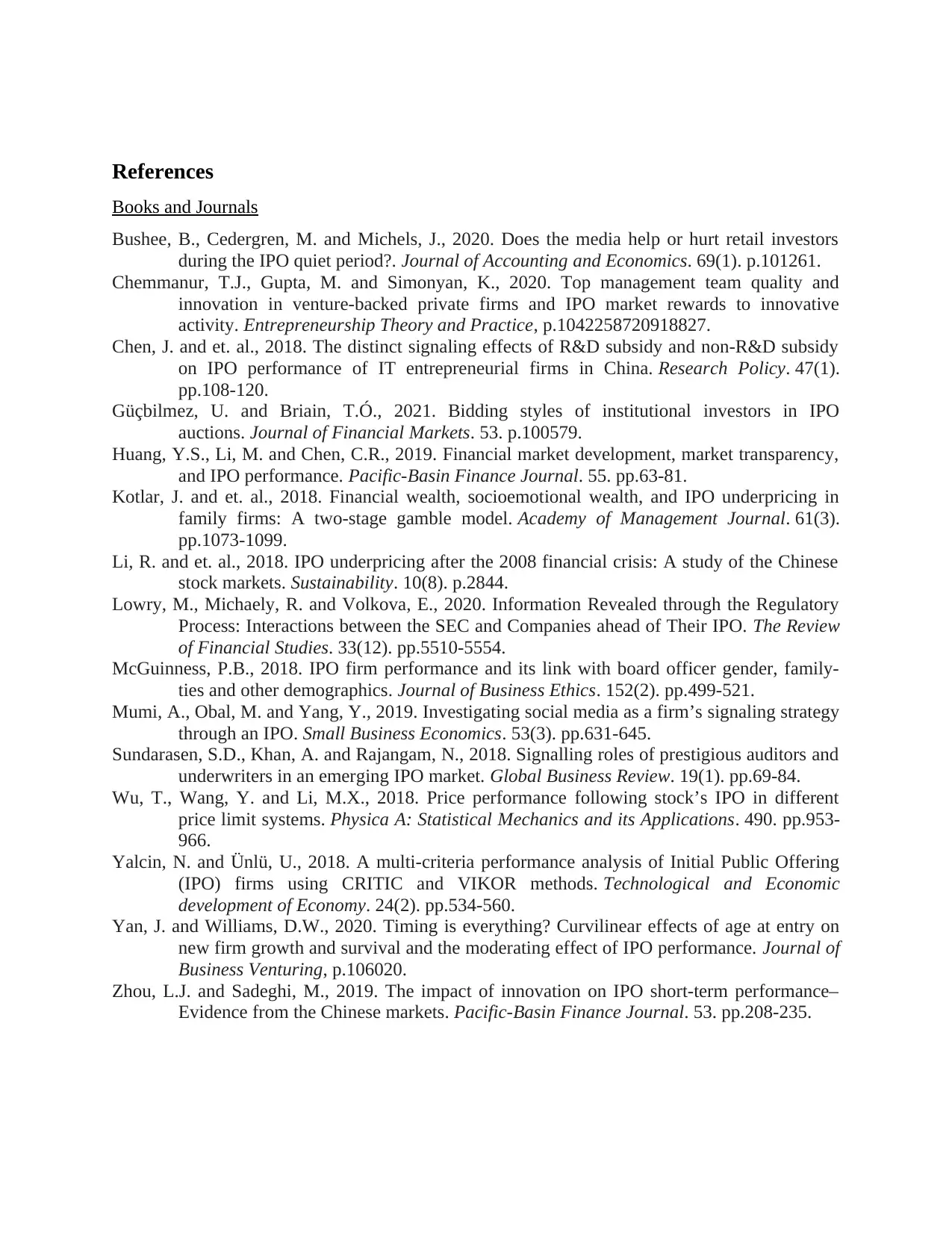
References
Books and Journals
Bushee, B., Cedergren, M. and Michels, J., 2020. Does the media help or hurt retail investors
during the IPO quiet period?. Journal of Accounting and Economics. 69(1). p.101261.
Chemmanur, T.J., Gupta, M. and Simonyan, K., 2020. Top management team quality and
innovation in venture-backed private firms and IPO market rewards to innovative
activity. Entrepreneurship Theory and Practice, p.1042258720918827.
Chen, J. and et. al., 2018. The distinct signaling effects of R&D subsidy and non-R&D subsidy
on IPO performance of IT entrepreneurial firms in China. Research Policy. 47(1).
pp.108-120.
Güçbilmez, U. and Briain, T.Ó., 2021. Bidding styles of institutional investors in IPO
auctions. Journal of Financial Markets. 53. p.100579.
Huang, Y.S., Li, M. and Chen, C.R., 2019. Financial market development, market transparency,
and IPO performance. Pacific-Basin Finance Journal. 55. pp.63-81.
Kotlar, J. and et. al., 2018. Financial wealth, socioemotional wealth, and IPO underpricing in
family firms: A two-stage gamble model. Academy of Management Journal. 61(3).
pp.1073-1099.
Li, R. and et. al., 2018. IPO underpricing after the 2008 financial crisis: A study of the Chinese
stock markets. Sustainability. 10(8). p.2844.
Lowry, M., Michaely, R. and Volkova, E., 2020. Information Revealed through the Regulatory
Process: Interactions between the SEC and Companies ahead of Their IPO. The Review
of Financial Studies. 33(12). pp.5510-5554.
McGuinness, P.B., 2018. IPO firm performance and its link with board officer gender, family-
ties and other demographics. Journal of Business Ethics. 152(2). pp.499-521.
Mumi, A., Obal, M. and Yang, Y., 2019. Investigating social media as a firm’s signaling strategy
through an IPO. Small Business Economics. 53(3). pp.631-645.
Sundarasen, S.D., Khan, A. and Rajangam, N., 2018. Signalling roles of prestigious auditors and
underwriters in an emerging IPO market. Global Business Review. 19(1). pp.69-84.
Wu, T., Wang, Y. and Li, M.X., 2018. Price performance following stock’s IPO in different
price limit systems. Physica A: Statistical Mechanics and its Applications. 490. pp.953-
966.
Yalcin, N. and Ünlü, U., 2018. A multi-criteria performance analysis of Initial Public Offering
(IPO) firms using CRITIC and VIKOR methods. Technological and Economic
development of Economy. 24(2). pp.534-560.
Yan, J. and Williams, D.W., 2020. Timing is everything? Curvilinear effects of age at entry on
new firm growth and survival and the moderating effect of IPO performance. Journal of
Business Venturing, p.106020.
Zhou, L.J. and Sadeghi, M., 2019. The impact of innovation on IPO short-term performance–
Evidence from the Chinese markets. Pacific-Basin Finance Journal. 53. pp.208-235.
Books and Journals
Bushee, B., Cedergren, M. and Michels, J., 2020. Does the media help or hurt retail investors
during the IPO quiet period?. Journal of Accounting and Economics. 69(1). p.101261.
Chemmanur, T.J., Gupta, M. and Simonyan, K., 2020. Top management team quality and
innovation in venture-backed private firms and IPO market rewards to innovative
activity. Entrepreneurship Theory and Practice, p.1042258720918827.
Chen, J. and et. al., 2018. The distinct signaling effects of R&D subsidy and non-R&D subsidy
on IPO performance of IT entrepreneurial firms in China. Research Policy. 47(1).
pp.108-120.
Güçbilmez, U. and Briain, T.Ó., 2021. Bidding styles of institutional investors in IPO
auctions. Journal of Financial Markets. 53. p.100579.
Huang, Y.S., Li, M. and Chen, C.R., 2019. Financial market development, market transparency,
and IPO performance. Pacific-Basin Finance Journal. 55. pp.63-81.
Kotlar, J. and et. al., 2018. Financial wealth, socioemotional wealth, and IPO underpricing in
family firms: A two-stage gamble model. Academy of Management Journal. 61(3).
pp.1073-1099.
Li, R. and et. al., 2018. IPO underpricing after the 2008 financial crisis: A study of the Chinese
stock markets. Sustainability. 10(8). p.2844.
Lowry, M., Michaely, R. and Volkova, E., 2020. Information Revealed through the Regulatory
Process: Interactions between the SEC and Companies ahead of Their IPO. The Review
of Financial Studies. 33(12). pp.5510-5554.
McGuinness, P.B., 2018. IPO firm performance and its link with board officer gender, family-
ties and other demographics. Journal of Business Ethics. 152(2). pp.499-521.
Mumi, A., Obal, M. and Yang, Y., 2019. Investigating social media as a firm’s signaling strategy
through an IPO. Small Business Economics. 53(3). pp.631-645.
Sundarasen, S.D., Khan, A. and Rajangam, N., 2018. Signalling roles of prestigious auditors and
underwriters in an emerging IPO market. Global Business Review. 19(1). pp.69-84.
Wu, T., Wang, Y. and Li, M.X., 2018. Price performance following stock’s IPO in different
price limit systems. Physica A: Statistical Mechanics and its Applications. 490. pp.953-
966.
Yalcin, N. and Ünlü, U., 2018. A multi-criteria performance analysis of Initial Public Offering
(IPO) firms using CRITIC and VIKOR methods. Technological and Economic
development of Economy. 24(2). pp.534-560.
Yan, J. and Williams, D.W., 2020. Timing is everything? Curvilinear effects of age at entry on
new firm growth and survival and the moderating effect of IPO performance. Journal of
Business Venturing, p.106020.
Zhou, L.J. and Sadeghi, M., 2019. The impact of innovation on IPO short-term performance–
Evidence from the Chinese markets. Pacific-Basin Finance Journal. 53. pp.208-235.
1 out of 11
Related Documents
Your All-in-One AI-Powered Toolkit for Academic Success.
+13062052269
info@desklib.com
Available 24*7 on WhatsApp / Email
![[object Object]](/_next/static/media/star-bottom.7253800d.svg)
Unlock your academic potential
© 2024 | Zucol Services PVT LTD | All rights reserved.





